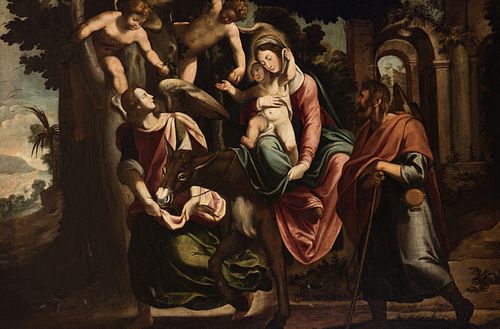Italian school; first third of the 17th century. "Flight into Egypt". Oil on canvas.
Lot 48
About Seller
Setdart Auction House
Carrer Aragó 346
Barcelona
Spain
Setdart Subastas was born in 2004 and is currently the first online art auction in Spain with solidity, prestige and reliability guaranteed by our more than 60,000 users. Setdart has a young, dynamic and enterprising team ready to successfully manage the purchase and sale of art works through custom...Read more
Estimate:
EUR€5,000 - EUR€6,000
$5,208.33 - $6,250
Absentee vs Live bid
Two ways to bid:
- Leave a max absentee bid and the platform will bid on your behalf up to your maximum bid during the live auction.
- Bid live during the auction and your bids will be submitted real-time to the auctioneer.
Bid Increments
| Price | Bid Increment |
|---|---|
| EUR€0 | EUR€10 |
| EUR€200 | EUR€25 |
| EUR€500 | EUR€50 |
| EUR€1,000 | EUR€100 |
| EUR€3,000 | EUR€200 |
| EUR€5,000 | EUR€500 |
| EUR€10,000 | EUR€1,000 |
| EUR€20,000 | EUR€2,000 |
| EUR€50,000 | EUR€5,000 |
About Auction
By Setdart Auction House
Nov 3, 2021
Set Reminder
2021-11-03 08:00:00
2021-11-03 08:00:00
America/New_York
Bidsquare
Bidsquare : OLD MASTERS
https://www.bidsquare.com/auctions/setdart-auction-house/old-masters-7786
Setdart Auction House sofia@setdart.com
Setdart Auction House sofia@setdart.com
- Lot Description
Italian school; first third of the 17th century. "Flight into Egypt". Oil on canvas. Measurements: 110 x 168 cm; 138 x 197 cm (frame). The figures that make up the scene are worked with an enormous idealism, highlighting the softness of the Virgin's face, the expressiveness of the hands, and the modulated lighting used manages to provide a greater physical presence, a greater three-dimensionality and also intensity and effectiveness to the figure. These features, as well as the chromatic range used, are typical features of the Italian baroque. Both the rotundity of the figures that make up the scene, the volumes, the use of a classical composition, in which the characters are arranged forming a triangle, located in the center of the scene, and the interest in drawing over color, indicate that this is the northern Italian scene. The flight into Egypt is an episode of the Gospel of St. Matthew very popular in the history of art. This passage has often been depicted to identify the Holy Family with those disadvantaged by emigration and political repression. The New Testament story, very brief and typical of the Gospel of Matthew, tells how an angel appears in a dream to St. Joseph and tells him that he must flee to Egypt with Mary and the Child, because King Herod was looking for him to kill him. Joseph obeys, and after a while he is ordered to return, in a similar manner. The evangelist himself sees in the episode the fulfillment of an Old Testament prophecy: "out of Egypt I called my son" (Hosea 11:1). In the apocryphal Gospels and in the later Christian tradition, this episode will be expanded with a multitude of anecdotes and miracles that occurred during the journey, among which we find the rest during the flight to Egypt, an obligatory pause for the Virgin to suckle the Child. This scene takes place in an idealized landscape, which shows the strong influence of 17th century Italian baroque models in this work, among other details. Although there are no horses, except for a donkey, and no bundles, the natural environment suggests the representation of the Rest in the Flight into Egypt, although the absence of such bundles could also mean that it is a Holy Family. However, both the presence of the little love birds, as well as the standing angel guiding the donkey, identify this religious scene in a concrete way, beyond the representation of the Holy Family. The figures that make up the scene are worked with an enormous idealism, highlighting the softness of the Virgin's face, the expressiveness of the hands, and the modulated lighting used manages to provide a greater physical presence, a greater three-dimensionality and also intensity and effectiveness to the figure. These features, as well as the chromatic range used, are typical features of the Italian baroque. Both the rotundity of the figures that make up the scene, the volumes, the use of a classical composition, in which the characters are arranged forming a triangle, located in the center of the scene, and the interest in drawing over color, indicate that this is the northern Italian scene. The flight into Egypt is an episode of the Gospel of St. Matthew very popular in the history of art. This passage has often been depicted to identify the Holy Family with those disadvantaged by emigration and political repression. The New Testament story, very brief and typical of the Gospel of Matthew, tells how an angel appears in a dream to St. Joseph and tells him that he must flee to Egypt with Mary and the Child, because King Herod was looking for him to kill him. Joseph obeys, and after a while he is ordered to return, in a similar manner. The evangelist himself sees in the episode the fulfillment of an Old Testament prophecy: "out of Egypt I called my son" (Hosea 11:1).
- Shipping Info
-
In-house shipping available. Please inquire at admin@setdart.com.
-
- Buyer's Premium



 EUR
EUR CAD
CAD AUD
AUD GBP
GBP MXN
MXN HKD
HKD CNY
CNY MYR
MYR SEK
SEK SGD
SGD CHF
CHF THB
THB

















